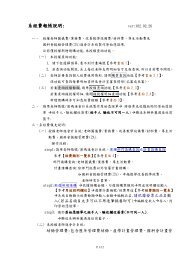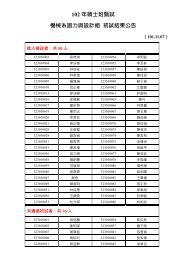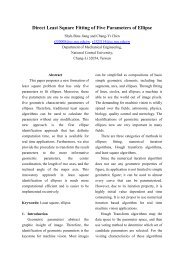An automatic fire searching and suppression system for large spaces
An automatic fire searching and suppression system for large spaces
An automatic fire searching and suppression system for large spaces
You also want an ePaper? Increase the reach of your titles
YUMPU automatically turns print PDFs into web optimized ePapers that Google loves.
ARTICLE IN PRESS<br />
T. Chen et al. / Fire Safety Journal 39 (2004) 297–307 299<br />
dispersedly, it is also not very efficient to install many sprinklers to cover all these<br />
materials.<br />
Now, robotic <strong>fire</strong> monitor that can be <strong>automatic</strong>ally controlled by computer <strong>and</strong><br />
can work as a linkage device in a <strong>fire</strong> detection <strong>and</strong> <strong>suppression</strong> <strong>system</strong> is becoming a<br />
more suitable solution. Liu et al. [7] <strong>and</strong> Yuan et al. [8] have done some early<br />
researches. Compared to a sprinkler, a <strong>fire</strong> monitor has many advantages. First, the<br />
most remarkable advantage is that the activation time of these <strong>fire</strong> monitors is much<br />
shorter than sprinklers. They are activated by the alarm signal given by the <strong>fire</strong><br />
detectors which are much more sensitive than the sprinklers’ explosion glass bulbs.<br />
These detectors can be conventional <strong>fire</strong> detectors or gas sensors. Second, water<br />
stream from a <strong>fire</strong> monitor has a higher speed, a greater flux <strong>and</strong> a <strong>large</strong>r impulse so<br />
it is more effective <strong>for</strong> <strong>fire</strong> <strong>suppression</strong>. Its spot type <strong>suppression</strong> may sometimes<br />
avoid the consequent losses caused by sprinklers <strong>and</strong> will not cause a downward<br />
moving of smoke [9] to endanger the occupants in the building. Last, a typical <strong>fire</strong><br />
monitor has a shooting range of 50 m long, which enables it to protect much <strong>large</strong>r<br />
area than a sprinkler.<br />
In this paper, a new <strong>fire</strong> <strong>searching</strong> <strong>and</strong> <strong>suppression</strong> <strong>system</strong> using such <strong>automatic</strong><br />
<strong>fire</strong> monitors is described. These <strong>fire</strong> monitors are assembled into a <strong>large</strong>r <strong>fire</strong><br />
detection–<strong>suppression</strong> <strong>system</strong>. After <strong>fire</strong> confirmation <strong>and</strong> <strong>searching</strong> process, the<br />
direction <strong>and</strong> elevation of the <strong>fire</strong> monitor can be easily calculated <strong>and</strong> <strong>suppression</strong><br />
can consequently be executed.<br />
2. Principle<br />
2.1. Structure of the <strong>automatic</strong> <strong>fire</strong> monitor <strong>system</strong><br />
The <strong>automatic</strong> <strong>fire</strong> monitor <strong>system</strong> is a <strong>fire</strong> detection–<strong>searching</strong>–<strong>suppression</strong><br />
<strong>system</strong> [10] which consists of three parts: the <strong>fire</strong> detection module (including<br />
detectors <strong>and</strong> the detector controller), the <strong>fire</strong> monitor module (including the <strong>fire</strong><br />
monitor, the <strong>fire</strong> monitor manual controller <strong>and</strong> the CCD camera) <strong>and</strong> the central<br />
control module (including the computer, data-sampling interfaces <strong>and</strong> communication<br />
interfaces). In this <strong>system</strong> (shown in Fig. 1), the <strong>fire</strong> monitor serves as a <strong>fire</strong><br />
<strong>searching</strong> <strong>and</strong> <strong>suppression</strong> device in conjunction with the <strong>fire</strong> detectors. Once the<br />
detector is in alarm state, the <strong>fire</strong> detection module will give a <strong>fire</strong> alarm signal <strong>and</strong><br />
the central control module will send a linkage signal to activate the corresponding<br />
<strong>fire</strong> monitor.<br />
The <strong>fire</strong> monitor module <strong>and</strong> the central control module accomplish the <strong>fire</strong><br />
<strong>searching</strong> <strong>and</strong> <strong>suppression</strong> after the <strong>fire</strong> monitor is activated. <strong>An</strong> <strong>automatic</strong> <strong>fire</strong><br />
monitor itself is much like a little barbette which consists of a chamber, a CCD<br />
camera, a motor, an electromagnet valve, a computer connection interface (RS485<br />
<strong>and</strong> video) <strong>and</strong> a shell. At the end of the <strong>fire</strong> monitor chamber, a CCD camera is<br />
fixed which is used <strong>for</strong> capturing the spot images. The optical axis of the CCD<br />
camera is adjusted parallel to the axis of the <strong>fire</strong> monitor chamber. In <strong>large</strong> space<br />
condition, the two axes can be practically considered coincident. The electromagnet

















